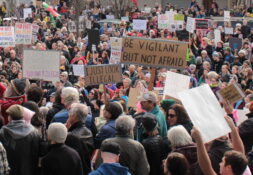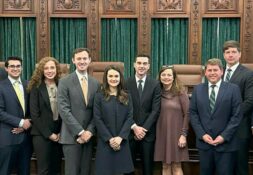Religious liberty concurrence offers first look at Justice Barrett’s jurisprudence
*Disclaimer: The views expressed in this article do not reflect those of the author, but rather serve as an attempt at seeing the case through the eyes of Associate Justice Amy Coney Barrett.
In a case pitting science-backed, state-mandated COVID restrictions against the First Amendment protection of religious free exercise, Justice Barrett makes her impact immediately felt on the High Court.
The case at bar, South Bay United Pentecostal v. Newsom, discusses three of California’s COVID orders. A comfortable eight Justice majority upheld the first restriction on procedural grounds and deemed the others—a categorical ban on indoor worship services and another ban on singing and chanting—properly before the Court. On these two points, the nine-member Court split neatly into thirds, with a trio of Justices supporting injunctive relief for zero, one, and two of the State’s bans.
To find out where Justice Barrett stood in this case, let’s take a closer look at her inaugural Supreme Court opinion.
The first line of Barrett’s single-paragraph concurrence begins, “I agree with Justice Gorsuch’s statement, save for…” A qualified endorsement no doubt, but one that Justice Barrett intentionally makes plain. Notably, the part of Gorsuch’s opinion that Barrett rejects is self-described as nothing more than a “quibble.” As for the meat of Justice Gorsuch’s statement, Justice Barrett wholeheartedly agrees.
Gorsuch’s opinion follows the well-established outline of late 20th-century religious liberty precedent. Indeed, the job of the Court here—as all of the Justices see it—is to apply the test prescribed by Lukumi Babalu Aye v. Hialeah (citing Employment Division v. Smith). This test has received its fair share of disapproval from all parts of the political spectrum in the years since the Court’s 1990 opinion in Smith. A case on this year’s docket, Fulton v. City of Philadelphia, may provide just the opportunity for the Justices to reconsider its merits. Nonetheless, not a single member of the Court so much as criticizes the test here.
To be precise, the Lukumi test to strike down a law for violating religious liberty has two parts. It begins with a neutrality test and is followed by the hallmark of civil liberties challenges: strict scrutiny. The law in question is to be enjoined only when it fails both tests.
In dissent, Justice Kagan, joined by the other two members of the Court’s so-called liberal bloc, finds California’s bans to hold up to the threshold neutrality test. Accordingly, she elects not to consider whether the orders were “narrowly-tailored” to a “compelling interest.” The main point of contention in this case is thus whether California’s COVID restrictions are “neutral” or “generally applicable.”
The Court turns first to California’s categorical ban on indoor religious services. Justice Gorsuch knows there are times where the neutrality standard can be tough to apply. But he finds no such difficulty here. Where retailers and other businesses are subject to 25-50% capacity restrictions, indoor worship of any kind is forbidden.
Justice Kagan sees things differently. She replies that the law is neutral because it applies “equivalently to religious activities and secular activities … found to pose a comparable COVID risk.” Kagan proposes judicial deference to the medical experts and policymakers who, in tandem, formulated risk-based categories for businesses. Religious institutions belong in the same category as concerts, restaurants, and political meetings. These activities, unlike merely “running in and out of a hardware store,” pose comparable COVID transmission risks and all face the same stringent restrictions. The neutrality requirement of “treating like cases alike” is hence satisfied.
But, Justice Gorsuch would tell us, if we look closely at the medical advice that Justice Kagan cites, we will find research-tested facts that “[n]o one before us disputes.” To a degree Justice Kagan is exactly right: it certainly requires an element of deference to take expert testimony as fact. The problem, however, lies in how lawmakers use those facts. It is one thing for an epidemiologist to opine that certain behaviors or settings, such as singing or a large group of people in a protracted gathering, are especially dangerous. It is another thing altogether for legislators to claim that indoor religious practice is inherently unsafe and rule it out from day one.
Put simply, the only quality unifying every event under the expansive umbrella of ‘worship services’—which conflates, for example, a high holiday service at a large shul with independent davening—is a religious purpose. The fallacy is lumping all religious institutions together as if every religious tradition is observed exactly the same way.
Instead, Justice Gorsuch calls for generally applicable laws that allow all businesses—religious and secular alike—to adjust. If a business wishes to remain open, it may modify its ordinary practices in order to follow these laws. Such mandates are already in place around the country and include occupancy restrictions, “social distancing requirements, masks, cleaning, plexiglass barriers, and like.” In fact, if the State wanted to force every business outdoors or limit all indoor events to the time it takes to grab a drill bit from Joe’s Hardware, those, too, would be generally applicable.
By contrast, asserting that religious institutions must be shuttered because their services necessarily result in certain heightened risks that sanctioned indoor businesses don’t (e.g., malls, train stations, buses, and manicurists) is impermissible discrimination. No scientific evidence can support a theory that practicing one’s religion indoors is inherently less safe than shopping at the mall. It all depends on what you do while you are there.
The State is picking winners and losers, starting innocently with valuable epidemiological advice, only to supplement it with its own prejudiced idea of how each particular business must operate. In so doing, the State doesn’t allow businesses to adapt to evolving COVID best practices, but instead shutters certain industries right from the outset. This practice may simply be an ill-advised way for a government to treat its businesses, but it becomes unconstitutional the very moment that the State leverages such differential treatment against religious institutions.
For her part, Justice Kagan holds firm that the businesses which the State favors, as compared to religious institutions, are “unlike cases, not like ones.” In fact, some of these industries test their employees “as many as three times a week”, she adds, “[which] ‘could not feasibly be applied to the congregation of a house of worship.’”
Perhaps Justice Kagan is right. But if the State really wanted to impose weekly testing quotas as a prerequisite to conducting indoor business, Justice Gorsuch would think that just fine. At least the State would give churches a fighting chance at compliance. Here, however, California decides a priori that no church could survive, banning all indoor worship services no questions asked.
Justice Gorsuch may well have stumbled upon a signpost of discrimination: “[t]he State’s spreadsheet summarizing its pandemic rules even assigns places of worship their own row.” Treating each organization separately and some harsher than others is differential treatment in its purest form.
Justice Barrett’s lone break from Gorsuch’s statement is, by all accounts, secondary. Of course, however, the independent Justice Barrett is not content to sign on to an opinion simply because she agrees with the crux of it. In considering the State’s singing and chanting ban, Barrett notes that the record evidence is unsettled. Whether any venue in California may host indoor singing “remains unclear.” And it is just too early to tell if and how the law might apply to the entertainment industry.
Evidently, Barrett does not see a singing and chanting ban as facially unconstitutional. Since the State could in theory send every business outdoors, it could just as easily proscribe singing—so long as the law applies equally “across the board.”
Yet Justice Barrett refuses to resort to speculation. The Court is not sufficiently informed to decide whether the ban is neutral as applied. Barrett concedes that taking Justice Gorsuch’s allegations at face value certainly triggers disturbing neutrality questions. Crucially then, her opinion leaves open the opportunity for the Church to raise this claim in the future.
Taking a step back from the minutiae, this second installment of South Bay United Pentecostal v. Newsom has particularly important upshots.
Unlike the last time these litigants were in front of the Court in May, Justice Barrett was not present. And unlike in May, the Court this time enjoins the enforcement of preferential restrictions that target places of worship, but favor or altogether exempt more ‘essential’ industries.
And yet another transformation has taken place since May. Justice Roberts has switched sides. Known as a loyal adherent to stare decisis (e.g., see June Medical Services v. Russo), perhaps the Chief Justice is simply following the Court’s similar ruling from November. Or perhaps Roberts wants his vote to count. Long considered the Court’s swing vote on partisan issues, Justice Roberts’s role has diminished with Justice Barrett’s arrival on the Court. At least now if he votes with the majority Roberts reserves the right to publish a persuasive concurrence, effect compromise, and, in cases outside this Court’s shadow docket, select the author of the majority opinion. Whatever the reason, one thing is certain: Justice Barrett wasted no time making a splash on the nation’s highest court.
Jason Brown is a Junior from Westerville, Ohio studying Computer Science and Honors Math. Find him watching college hoops reruns, baking braided bread, or fantasizing about his favorite beach in Hawaii. If he’s late to an appointment, don’t be alarmed, his watch is stuck on island time. Send sunset pics to jbrown38@nd.edu.






Leave a Reply